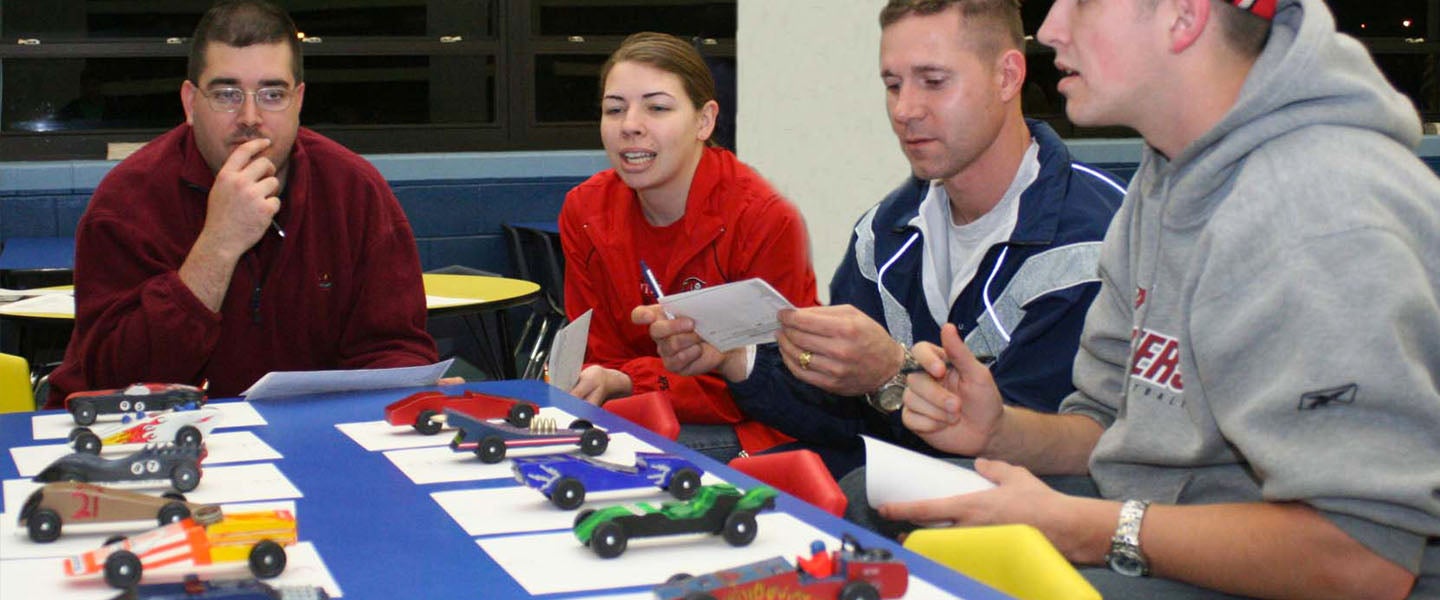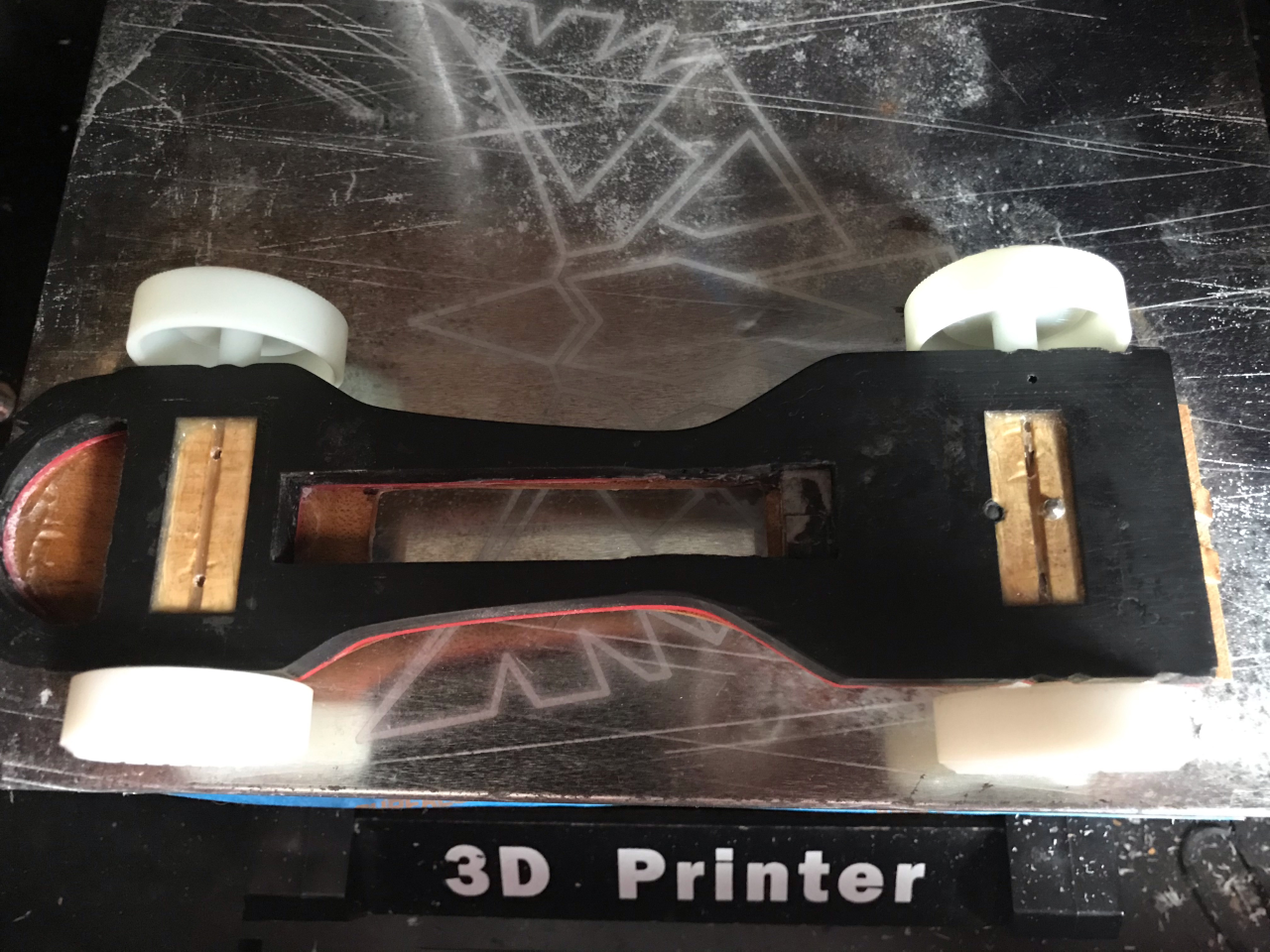The Pinewood Derby race is next week, and Mason Carson believes he and his 11-year-old Cub Scout son have a winning car: a sleek, low-profile, Batmobile-esque chassis. “It’s all hand-carved wood on the very top, but that piece of wood is only about as thick as a toothpick,” raves Carson, who lives in Aroostook County in northern Maine.
The rest of the car? Acrylonitrile butadiene styrene, created with pro software and molded in a 3D printer.
“The whole base is 3D-printed, except where the wheels go on the underside,” Carson says. “Then I’ll put some tungsten in, and because it’s denser than lead, I can center it better over the rear wheels.”
The Pinewood Derby is a lightning-quick battle of engineering, woodwork and graphite lubricant; fates and glories are sealed in a matter of seconds. With a total weight limit of 5 ounces to consider, every precise measurement matters when you’re building a racer. Lately, Derby families like the Carsons have realized wood can take them only so far if they want to win.
It’s time to embrace the future. So to give themselves an edge, this father-son team “took out the physics book” — and a lot more.

3D Printing to Keep Up
Carson designed the car with CAD software (short for “computer-aided design”) to be exceptionally aerodynamic. He’s relentlessly tweaked it to have a perfect weight balance. He sent over a photo album of their progress. The classic car-building fundamentals I remember from my scouting days are still there — sanding down a wood block, painting it and taping some fishing sinkers to the top — but “nowadays,” Carson notes, “it’s totally different.”
For one thing, the internet has brought a market for premade, professionally engineered Pinewood Derby cars. “People have eBay, they buy super-fast premade cars for like $500,” Carson says. “It seems like it totally undermines the purpose [of the Pinewood Derby], but there are parents out there who gotta get their kid the gold medal, and they’ll do whatever it takes. You know what I’m saying?”
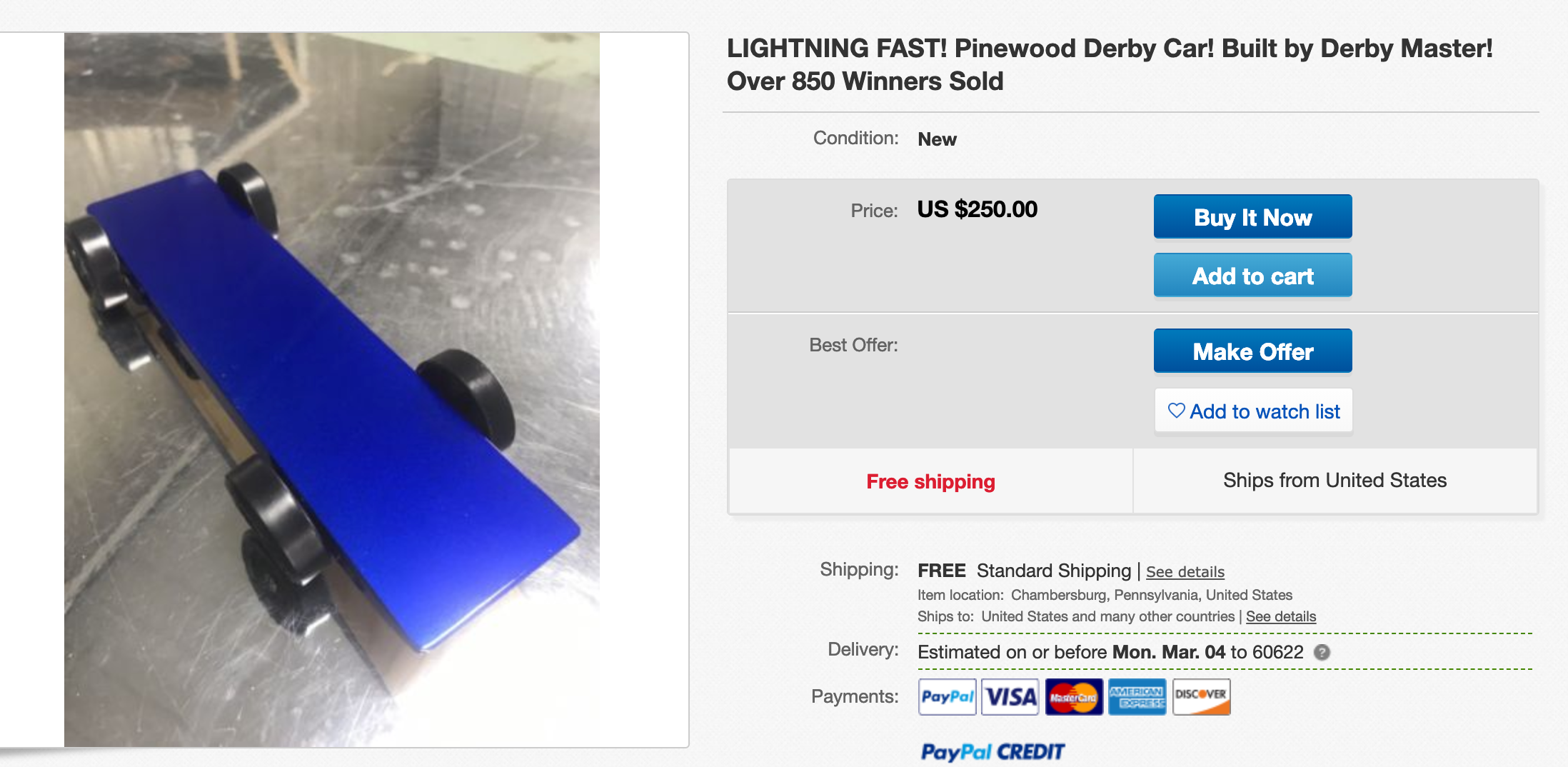
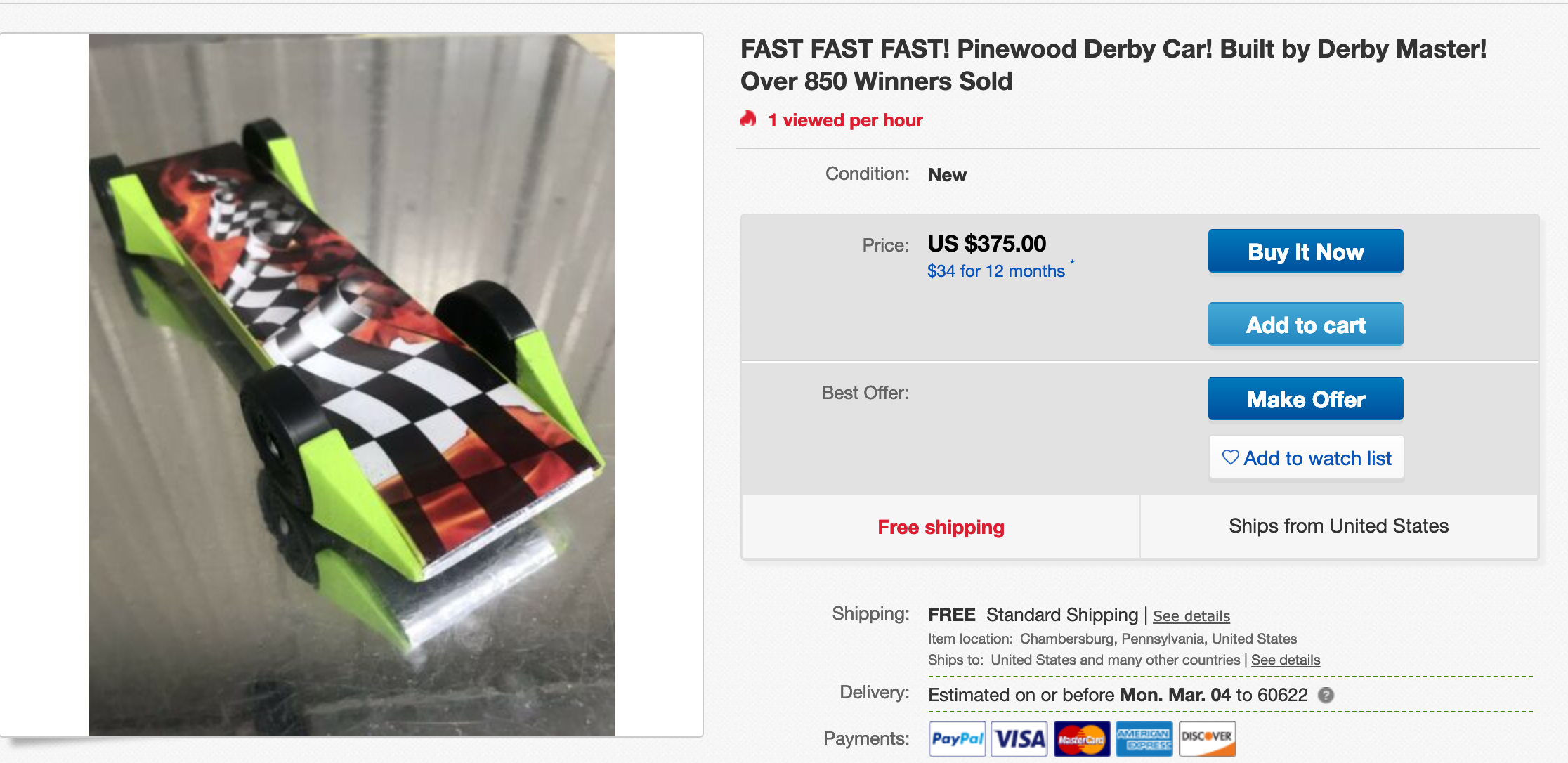
“It’s impossible to compete with the guys who just buy their cars,” he says. They needed to up the ante from simply sanding down a block of wood; 3D printing was the most effective way to avoid a devastating loss.
Unless specific Scout troops make rules against premade cars, gone are the days of everyone racing amateur, hobbled-together models for fun. The new breed of dads want to win, no matter the cost.
The Big Business of Pinewood Derby Cars
“There is more emphasis on winning today than there was when I was a Scout,” says Steve Robbins, owner of the online Pinewood Derby car store Derby Monkey Garage. Robbins and his dad built his first Pinewood Derby model in 1966, he tells MEL, back “when, pretty much, you just slap some weight on the wood, add some wheels on it and hope for the best.”
It wasn’t an engineering-driven contest then, he says. “There was very little science involved.” But when 2008 rolled around and his son’s car “didn’t do that well” in his first Pinewood Derby race, he realized everything had changed.
“We started getting involved in the science aspect of it — weight placement, location of the center of gravity, low-profile bodies, polishing the axles and the insides of the wheel bores, proper lubrication and bending or canting the axles.”
Robbins says in the time between his first Pinewood Derby race and his son’s, people had figured out how to make the fastest car possible. And that goes well beyond aerodynamics. Robbins points me to a video by YouTuber Mark Rober, whose breakdown of the physics necessary to build a fast Pinewood Derby car has over 13 million views:
‘I Want the Best of Everything Because My Boy Is Going to Win’
Robbins says he started selling pre-cut cars because men no longer have the woodworking skills necessary to build a competitive car.
“In the ’50s and ’60s, when it was mostly the boy building the car with the dad, the dad had some woodworking skills and probably had several woodworking tools,” he tells MEL. “But as we have gone on into the 2000s, there are fewer dads that have the woodworking skills or the tools. And then there’s unfortunately so many kids that don’t even have an active dad. You know, the people like this, like they don’t really possess the skills and the tools to cut out a car body out of that block of wood.”
While Robbins maintains that he’s not selling any “finished cars,” or cars that you simply buy and race, he does go into detail on just how much better off you are buying one of his kits that “still need to be sanded, painted, decals put on and lubrication and all that,” instead of making your own.
Robbins says there are lots of Pinewood Derby dads out there for whom money is no issue. “I want the best of everything because my boy is going to win,” Robbins says, mimicking the type of dad who buys supplies from his store. “Four ounces of tungsten is going to retail for about $20. The pre-polished and pre-bent axles retail for about $50. The official BSA Pinewood Derby wheels that have been lightened and treated on the lathe to make sure they’re perfectly round and balanced and as light as possible retail for about $40.”
At first, Robbins says, Scout packs didn’t allow pre-cut cars like his into the races. “But they soon realized the same thing we did: There are so many boys who cannot participate because their parents or their mother did not have the skills to cut out a car body.”
“We sell car kits on our website that are only a quarter of an inch thick, and we cut those with the laser cutter, because then it’s perfect to put tungsten cubes [into] and push the center of gravity back as far as we safely can, so you have more control over your center of gravity,” he says.
For what it’s worth, Robbins maintains that his kits still require some assembly, which he hopes is done by the parents and kids together. “There’s still a lot the boy and a parent can do together, with this starting them off in the right direction,” he says. “There are no finished cars on our website.”
Carson shows me an eBay listing for a Pinewood Derby car made by a “derby master” boasting “over 850 winners sold.” “These cars are usually made on a CNC machine and have CNC-milled wheels and axles for almost no friction,” Carson says. “Definitely not the Pinewood I remember as a kid.”
“I don’t know why [parents buy completed cars],” Robbins laments. “They just really don’t have time to spend with their kids, or they don’t want to — they’re just hoping to buy a fast car that’s going to win everything.”
The Rest of the Pack
So as Robbins sells lubricated axles and aerodynamically sound bodies, and Carson designs his car in CAD to find the perfect center of gravity, where does that leave everyone else?
Brian, a 53-year-old father of four Boy Scouts, has been a Scout leader for 12 years. He’s not a fan of the direction the Pinewood Derby has taken lately, and he’s “a firm believer in the kids doing most of the work as he’s able to do at his age.”
“By the time [my kids] hit their Webelos year” — fourth or fifth grade — “they would be doing the predominant amount of work,” he says. “I was just helping them with the more dangerous tools like the drill and bandsaw so that they didn’t cut their fingers off … then I would help guide them to a reasonably competitive car with polishing techniques.”
He admits that he and his sons have “studied several books and websites on how to become more competitive in our designs,” but beyond providing resources, he wants his sons to “build a reliance on their abilities — and to me that’s much more important than just winning for winning’s sake.”
Brian says he’s built 30 cars with his family. “Some of the cars have been very very successful,” he says, “and some of them have been not so great, but it was all dependent on the amount of work that the kid was willing to put in.”
Brian’s dedication to teaching his kids lessons beyond how to win is the reason he thinks 3D printing should be banned. “3D printing a car kind of violates the spirit of using the block and the tires and the nails that came in the box, which is sort of the heart of the rules that we’ve played by,” he says.
The Inevitable Future of the Pinewood Derby
Carson argues that 3D printing isn’t going anywhere, and the Scouts should just adapt. Yes, his car was 3D-printed, he says, but he still spent quality time with his son, designing the car in CAD and learning the physics of the race, instead of chopping and sanding wood.
“My son is 11 years old and I’ve been teaching him CAD, just the basics,” Carson says. “I set him up a little simple program to use. It’s something I want him to develop in skill, you know? Because it’s the future.
“I’ll explain, kind of dumbed-down, so he can get what’s going on, but I’m not going to get into the technical things like calibrating and canting your wheels to the perfect angles, or friction coefficients and how much mesh graphite I use.” He laughs. “So I sat there and calculated everything to the millimeter, but I don’t really go into a whole lot of that with him because it’s just going to overwhelm him.”
“There are certain limitations to what the kids can actually do,” Carson adds. “I’m not going to let him polish the axles at 30,000 rpms or handle my drill press and end up in the ER. But as long as he’s understanding what’s going on in the process, that this is why we’re doing what, then I’m happy.” Carson says his son does “everything else” — from the concept to the painting and “rough work.”
“Science classes are already putting 3D printers in their classes, they’re teaching kids Raspberry Pi and how to program basic robotics stuff, so I think it’s going to eventually be something comparable to woodworking, where if you want something made, you’re going to 3D-print it,” he tells MEL.
Plus, the worlds are merging, whether or not traditional Pinewood parents accept it. 3D-printing firm Finnovation PD in Rochester, New York, outlined a plan to invite that year’s Pinewood Derby winners to an alternative to the Pinewood Derby called the “Future Derby.” Here, the company would “expose young designers to the latest in computer-aided design and 3D printing technology.”
Boy Scouts of America did not respond to my inquiry about 3D printing. According to Boys’ Life — the official media arm of the Boy Scouts — there are no national Pinewood Derby rules, so unless national guidelines are put in place, or 3D printing is banned altogether, everything Carson is doing is perfectly legal by way of his local pack’s rules.
“I’ve done 3D-printed stuff for a couple of years now, and we’re going to race next week with one that’s, like, 99 percent 3D-printed,” he tells MEL. “But I’m very adamant on sticking to the rules as written in the book in case they ever say anything. Everything is right to the letter.
“The rules say they have to have the original axle slots from the wood,” he continues. “So what I do is take out my band saw and cut a 16th-of-an-inch-thin piece of wood off the original block that’s the axle slot and basically coat it in ABS plastic.”
As for Brian, so long as he’s a Scout leader, he’s going to implement some rules. “What sort of levels the playing field, a bit like Formula One,” is “limiting people to using what’s in the box, and not buying pre-manufactured or machined parts off the internet, and no machining the wheels to reduce drag.” This way, Brian says, “people who don’t have all the money in the world can still be reasonably competitive.”
Should Pinewood Dads Get Their Own Race?
Brian adds another option, one that’s gained popularity across many Scout troops. By offering two races — one for the boys and one for the adults — parents are less likely to commandeer the process.
“Keeping the dads out of the race this is been a topic that we’ve been dealing with for years,” Brian says. “You can obviously tell which kids spend time with their car and which ones where the father built 90 percent of it, so as Scout leader, one of the things that I felt was important was taking taking the dads out of the Cub Scout race and allowing them to run their own car in what we call an ‘Open Division.’”
This “allows the fathers to go crazy,” Brian continues. “Put special axles in and leave the wheels, and do all sorts of fun stuff that doesn’t include CO2-powered missiles, basically. These open races made for much more competitive and fun child-built cars for the Cubs to race, and the fathers can build their way-out, super-competitive cars and get that out of their systems as well.”
While separate events for adults and kids might replace the feelings of father-son teamwork with individual glory, Robbins says in his 52 years of being involved with Pinewood Derby races, it’s always been the dads who are more interested in winning.
“It has a lot to do with, you know, ‘my dad wants to beat your dad,’” he says. “The dads that are buying all of the the speed products and the low-profile bodies and the tungsten… I’ve attended a whole lot of Pinewood Derby car races, and most of the boys there don’t really care if they win. They just want to have fun or they want a cool-looking car. Like, we have an army tank, it’s a big ol’ chunk of wood. It’s not aerodynamic at all, and it never wins anything. But you know when the kid has most of the say, and that’s usually the type of cars they’re going to get: something that looks cool.”
Carson argues that you can have both. He points to a 3D-printed Back to the Future–inspired car and tells me, “We won first place.”
He and his son “got a huge trophy and it blew the other cars away. And that’s what I’m hoping to do again next week.”
